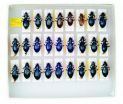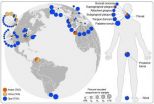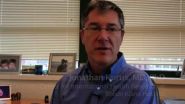(Press-News.org) NEW YORK, NY (May 22, 2014) — Researchers have discovered how a gene commonly linked to obesity—FTO—contributes to weight gain. The study shows that variations in FTO indirectly affect the function of the primary cilium, a little-understood hair-like appendage on brain and other cells. Specific abnormalities of cilium molecules, in turn, increase body weight, in some instances, by affecting the function of receptors for leptin, a hormone that suppresses appetite. The findings, made in mice, suggest that it might be possible to modify obesity through interventions that alter the function of the cilium, according to scientists at Columbia University Medical Center (CUMC).
"If our findings are confirmed, they could explain how common genetic variants in the gene FTO affect human body weight and lead to obesity," said study leader Rudolph L. Leibel, MD, the Christopher J. Murphy Memorial Professor of Diabetes Research, professor of pediatrics and medicine, and co-director of the Naomi Berrie Diabetes Center at CUMC. "The better we can understand the molecular machinery of obesity, the better we will be able to manipulate these mechanisms and help people lose weight."
The study was published on May 6 in the online edition of Cell Metabolism.
Since 2007, researchers have known that common variants in the fat mass and obesity-associated protein gene, also known as FTO, are strongly associated with increased body weight in adults. But it was not understood how alterations in FTO might contribute to obesity. "Studies have shown that knocking out FTO in mice doesn't necessarily lead to obesity, and not all humans with FTO variants are obese," said Dr. Leibel. "Something else is going on at this location that we were missing."
In experiments with mice, the CUMC team observed that as FTO expression increased or decreased, so did the expression of a nearby gene, RPGRIP1L. RPGRIP1L is known to play a role in regulating the primary cilium. "Aberrations in the cilium have been implicated in rare forms of obesity," said Dr. Leibel. "But it wasn't clear how this structure might be involved in garden-variety obesity."
Dr. Leibel and his colleague, George Stratigopoulos, PhD, associate research scientist, hypothesized that common FTO variations in noncoding regions of the gene do not change its primary function, which is to produce an enzyme that modifies DNA and RNA. Instead, they suspected that FTO variations indirectly affect the expression of RPGRIP1L. "When Dr. Stratigopoulos analyzed the sequence of FTO's intron—its noncoding, or nonprotein-producing, portion—we found that it serves as a binding site for a protein called CUX1," said Dr. Leibel. "CUX1 is a transcription factor that modifies the expression of RPGRIP1L."
Next, Dr. Stratigopoulos set out to determine whether RPGRIP1L plays a role in obesity. He created mice lacking one of their two RPGRIP1L genes, in effect, reducing but not eliminating the gene's function. (Mice that lack both copies of the gene have several serious defects that would obscure the effects on food intake.) Mice with one copy of RPGRIP1L had a higher food intake, gained significantly more weight, and had a higher percentage of body fat than controls.
In a subsequent experiment, the CUMC team found that RPGRIP1L-deficient mice had impaired leptin signaling. "The receptors didn't convene properly on the cell surface around the base of cilium," said Dr. Leibel. "RPGRIP1L appears to play a role in getting leptin receptors to form clusters, where they are more efficient in signaling."
"Overall," said Dr. Leibel, "our findings open a window onto the possible role of the primary cilium in common forms of obesity."
The CUMC team is now conducting studies to learn more about the various components of the FTO- RPGRIP1L pathway, which ciliary proteins are affected by changes in this pathway, and how these proteins mediate actions of leptin receptors.
INFORMATION:
The paper is titled, "Hypomorphism for RPGRIP1L, a Ciliary Gene Vicinal to the FTO Locus, Causes Increased Adiposity in Mice." The other contributors are Jayne F. Martin Carli (CUMC), Diana R. O'Day (University of Washington, Seattle, WA), Liheng Wang (CUMC), Charles A. LeDuc (CUMC), Patricia Lanzano (CUMC), Wendy K. Chung (CUMC), Michael Rosenbaum (CUMC), Dieter Egli (CUMC), and Daniel A. Doherty (University of Washington).
The authors declare no financial or other conflicts of interests.
The study was supported by grants from the National Institutes of Health (DK52431-15, DK26687-30, NS064077, and DK097399-01).
The Naomi Berrie Diabetes Center at CUMC opened in 1998 to serve the 1.6 million people with diabetes in the New York area, by combining world-class diabetes research and education programs with family-oriented patient care. Founded with support from the Russell Berrie Foundation and other friends, the center is named in honor of the mother of the late Russell Berrie, founder of RUSS™ Toys. The center's more than 100 faculty and students conduct basic and clinical research related to the pathogenesis and treatment of all forms of diabetes and its complications. For more information, visit http://www.nbdiabetes.org.
Columbia University Medical Center provides international leadership in basic, preclinical, and clinical research; medical and health sciences education; and patient care. The medical center trains future leaders and includes the dedicated work of many physicians, scientists, public health professionals, dentists, and nurses at the College of Physicians and Surgeons, the Mailman School of Public Health, the College of Dental Medicine, the School of Nursing, the biomedical departments of the Graduate School of Arts and Sciences, and allied research centers and institutions. Columbia University Medical Center is home to the largest medical research enterprise in New York City and State and one of the largest faculty medical practices in the Northeast. For more information, visit cumc.columbia.edu or columbiadoctors.org.
Study shows how common obesity gene contributes to weight gain
Affects a second gene linked to a hair-like appendage on brain cells
2014-05-22
ELSE PRESS RELEASES FROM THIS DATE:
Scientific collections play vital role in conservation biology
2014-05-22
Scientists from the California Academy of Sciences and more than 60 other international research institutions spanning six continents have responded to a recent paper in Science, which questioned current methods of scientific collecting and advocated the use of non-lethal alternatives. The response, led by Luiz Rocha, Ph.D., the Academy's Assistant Curator and Follett Chair of Ichthyology, and co-authored by such science luminaries as Harvard's E. O. Wilson and the Academy's Chief of Science and Sustainability, Margaret (Meg) Lowman, describes in detail the value that scientific ...
A glimpse into nature's looking glass -- to find the genetic code is reassigned
2014-05-22
In the Lewis Carroll classic, Through the Looking Glass, Humpty Dumpty states, "When I use a word, it means just what I choose it to mean—neither more nor less." In turn, Alice (of Wonderland fame) says, "The question is, whether you can make words mean so many different things." All organisms on Earth use a genetic code, which is the language in which the building plans for proteins are specified in their DNA. It has long been assumed that there is only one such "canonical" code, so each word means the same thing to every organism. While a few examples of organisms ...
RI Hospital researcher and colleagues discover protein that may lead to malaria vaccine
2014-05-22
VIDEO:
Jonathan Kurtis, M.D., Ph.D., director of the Center for International Health Research at Rhode Island Hospital, talks about the latest findings in their research to find a vaccine for malaria,...
Click here for more information.
PROVIDENCE, R.I. – Rhode Island Hospital researchers have discovered a protein that is essential for malaria-causing parasites to escape from inside red blood cells. Antibodies to this protein trap the parasite inside these red blood cells. This ...
Growing inequalities make science more of a 'winner takes all' field
2014-05-22
ANN ARBOR—As new research documents growing inequalities in health and wealth, the gap between "haves" and "have-nots" is growing in the field of scientific research itself, says University of Michigan sociologist Yu Xie.
"It's surprising that more attention has not been paid to the large, changing inequalities in the world of scientific research, given the preoccupation with rising social and economic inequality in many countries," said Xie, research professor at the U-M Institute for Social Research and professor of sociology, statistics and public policy.
The forces ...
Fruit flies show mark of intelligence in thinking before they act
2014-05-22
Fruit flies 'think' before they act, a study by researchers from the University of Oxford's Centre for Neural Circuits and Behaviour suggests. The neuroscientists showed that fruit flies take longer to make more difficult decisions.
In experiments asking fruit flies to distinguish between ever closer concentrations of an odour, the researchers found that the flies don't act instinctively or impulsively. Instead they appear to accumulate information before committing to a choice.
Gathering information before making a decision has been considered a sign of higher intelligence, ...
Collecting biological specimens essential to science and conservation
2014-05-22
ANN ARBOR—Collecting plant and animal specimens is essential for scientific studies and conservation and does not, as some critics of the practice have suggested, play a significant role in species extinctions.
Those are the conclusions of more than 100 biologists and biodiversity researchers who signed a letter to the journal Science scheduled for online publication May 22.
The letter is a response to an April 18 Perspectives article in Science arguing that alternative methods of documentation—such as high-resolution photography, audio recordings and nonlethal tissue ...
Newborn health improves despite income gap
2014-05-22
The U.S. economic inequality gap has been widening for decades, and research shows that maternal disadvantage may have health consequences for newborns. A review of recent economic research, however, finds that the health of newborns has actually improved nationally in recent years, despite data that would suggest otherwise.
"That was really surprising to us," said Anna Aizer, associate professor of economics at Brown University. Aizer and Janet Currie of the National Bureau of Economic Research and Princeton University published the review in a special issue of Science ...
Ancient DNA ends Aussie claim to kiwi origins
2014-05-22
Australia can no longer lay claim to the origins of the iconic New Zealand kiwi following University of Adelaide research published in the journal Science today showing the kiwi's closest relative is not the emu as was previously thought.
Instead, the diminutive kiwi is most closely related to the extinct Madagascan elephant bird – a 2-3 metre tall, 275 kg giant. And surprisingly, the study concluded, both of these flightless birds once flew.
A new study by the University of Adelaide's Australian Centre for Ancient DNA (ACAD), has solved a 150-year-old evolutionary ...
Scientists identify potential vaccine candidate for pediatric malaria
2014-05-22
WHAT:
Researchers have identified a substance, or antigen, that generates antibodies that can hinder the ability of malaria parasites to multiply, which may protect against severe malaria infection. The antigen, known as PfSEA-1, was associated with reduced parasite levels among children and adults in malaria-endemic areas. Mice exposed to PfSEA-1 in an investigational vaccine also experienced lower malaria parasite levels. The discovery of PfSEA-1 could be a critical addition to the limited pool of antigens currently used in candidate malaria vaccines. The findings, which ...
Lower mantle chemistry breakthrough
2014-05-22
Washington, D.C.—Breaking research news from a team of scientists led by Carnegie's Ho-kwang "Dave" Mao reveals that the composition of the Earth's lower mantle may be significantly different than previously thought. These results are to be published by Science.
The lower mantle comprises 55 percent of the planet by volume and extends from 670 and 2900 kilometers in depth, as defined by the so-called transition zone (top) and the core-mantle boundary (below). Pressures in the lower mantle start at 237,000 times atmospheric pressure (24 gigapascals) and reach 1.3 million ...
LAST 30 PRESS RELEASES:
Numbers in our sights affect how we perceive space
SIMJ announces global collaborative book project in commemoration of its 75th anniversary
Air pollution exposure and birth weight
Obstructive sleep apnea risk and mental health conditions among older adults
How talking slows eye movements behind the wheel
The Ceramic Society of Japan’s Oxoate Ceramics Research Association launches new international book project
Heart-brain connection: international study reveals the role of the vagus nerve in keeping the heart young
Researchers identify Rb1 as a predictive biomarker for a new therapeutic strategy in some breast cancers
Survey reveals ethical gaps slowing AI adoption in pediatric surgery
Stimulant ADHD medications work differently than thought
AI overestimates how smart people are, according to HSE economists
HSE researchers create genome-wide map of quadruplexes
Scientists boost cell "powerhouses" to burn more calories
Automatic label checking: The missing step in making reliable medical AI
Low daily alcohol intake linked to 50% heightened mouth cancer risk in India
American Meteorological Society announces Rick Spinrad as 2026 President-Elect
Biomass-based carbon capture spotlighted in newly released global climate webinar recording
Illuminating invisible nano pollutants: advanced bioimaging tracks the full journey of emerging nanoscale contaminants in living systems
How does age affect recovery from spinal cord injury?
Novel AI tool offers prognosis for patients with head and neck cancer
Fathers’ microplastic exposure tied to their children’s metabolic problems
Research validates laboratory model for studying high-grade serous ovarian cancer
SIR 2026 delivers transformative breakthroughs in minimally invasive medicine to improve patient care
Stem Cell Reports most downloaded papers of 2025 highlight the breadth and impact of stem cell research
Oxford-led study estimates NHS spends around 3% of its primary and secondary care budget on the health impacts of heat and cold in England
A researcher’s long quest leads to a smart composite breakthrough
Urban wild bees act as “microbial sensors” of city health.
New study finds where you live affects recovery after a hip fracture
Forecasting the impact of fully automated vehicle adoption on US road traffic injuries
Alcohol-related hospitalizations from 2016 to 2022
[Press-News.org] Study shows how common obesity gene contributes to weight gainAffects a second gene linked to a hair-like appendage on brain cells


